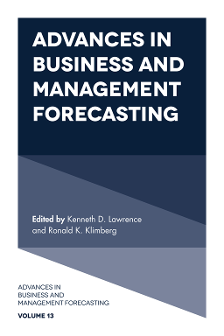
Index
Advances in Business and Management Forecasting
ISBN: 978-1-78754-290-7, eISBN: 978-1-78754-289-1
ISSN: 1477-4070
Publication date: 6 September 2019
Citation
(2019), "Index", Advances in Business and Management Forecasting (Advances in Business and Management Forecasting, Vol. 13), Emerald Publishing Limited, Leeds, pp. 135-139. https://doi.org/10.1108/S1477-407020190000013001
Publisher
:Emerald Publishing Limited
Copyright © 2019 Emerald Publishing Limited
INDEX
- Prelims
- Section A Marketing, Sales, and Service Forecasting
- Exploring the Suitability of Support Vector Regression and Radial Basis Function Approximation to Forecast Sales of Fortune 500 Companies
- Buy-online-and-pick-up-in-store Strategy and Showroom Strategy in the Omnichannel Retailing
- Service Contracts for Delays in Delivery
- Section B Economic, Financial, and Insurance Forecasting
- Growth, Business Cycles, and the Great Recession: Comparing State and County Unemployment Costs Per Capita for North Carolina
- Dimension Reduction in Bankruptcy Prediction: A Case Study of North American Companies
- Detecting Non-injured Passengers and Drivers in Car Accidents: A New Under-resampling Method for Imbalanced Classification
- Section C CEO Compensation and Operations Forecasting
- Regression Modeling of the Peer Group of Verizon Corporation for the CEO of Verizon
- Regression Modeling Based on a Peer Group for the Executive Compensation of AT&T CEO
- Agent-based Queuing Model for Call Center Forecasting and Management Optimization
- Index